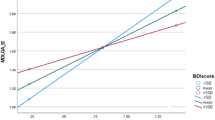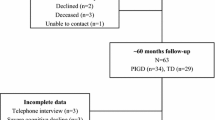Abstract
Symptoms of Parkinson’s disease (PD) progress over time causing significant disability. Yet, change in disability over shorter time periods has not been entirely understood. The purpose of this study was to assess the Self-Assessment Disability Scale (SADS) in persons with Parkinson’s disease (PD) after 2 years of follow-up and compare it with the score observed at baseline. Additionally, we aimed at evaluating association of motor and non-motor PD features at baseline with a higher disability after 2 years of follow-up. A total of 120 consecutive persons with PD, who denied falling in the past 6 months, were initially recruited. After 2 years of follow-up, 88 (73.3%) persons with PD were evaluated for SADS. The total disability (SADS) score did not change after follow-up (p = 0.529). We observed increase in difficulty at “Getting out of bed” (p = 0.006), “Getting up out of armchair” (p = 0.013), “Walking about house/flat” (p = 0.003), “Walking outside” (p = 0.010), and “Traveling by public transport” (p = 0.014). After adjusting for several potential confounding factors, falls in the past year (β = 8.32, 95% confidence interval (CI) 1.04–15.59) and higher Unified Parkinson’s Disease Rating Scale part 3 at baseline (β = 0.26, 95%CI 0.01–0.51) remained associated with higher PD-related disability. This finding suggests that accumulation of overall PD-related disability tends to occur over a longer time span. Further studies are needed to gradually assess long-term evolution of disability in PD.
Similar content being viewed by others
References
Rodriguez-Oroz MC, Jahanshahi M, Krack P, Litvan I, Macias R, Bezard E, Obeso JA (2009) Initial clinical manifestations of Parkinson’s disease: features and pathophysiological mechanisms. Lancet Neurol 8:1128–1139
Cilia R, Cereda E, Klersy C et al (2015) Parkinson's disease beyond 20 years. J Neurol Neurosurg Psychiatry 86:849–855
Armstrong MJ, Gruber-Baldini AL, Reich SG, Fishman PS, Lachner C, Shulman LM (2014) Which features of Parkinson’s disease predict earlier exit from the workforce? Parkinsonism Relat Disord 20:1257–1259
Gazibara T, Kisic-Tepavcevic D, Svetel M, Tomic A, Stankovic I, Kostic VS, Pekmezovic T (2016) Recurrent falls in Parkinson’s disease after one year of follow-up: a nested case-control study. Arch Gerontol Geriatr 65:17–24
Lindholm B, Hagell P, Hansson O, Nilsson MH (2014) Factors associated with fear of falling in people with Parkinson’s disease. BMC Neurol 14:19
Hely MA, Morris JGL, Reid WGJ, Trafficante R (2005) Sydney multicenter study of Parkinson’s disease: non-L-dopa-responsive problems dominate at 15 years. Mov Disord 20:190–199
Brown R, Maccarthey B, Jahanshai M, Marsden D (1989) Accuracy of self-reported disability in patients with Parkinson’s disease. Arch Neurol 46:955–959
Gazibara T, Stankovic I, Tomic A, Kisic-Tepavcevic D, Kostic VS, Pekmezovic T (2013) Validation and cross-cultural adaptation of the self-assessment disability scale in patients with Parkinson’s disease in Serbia. J Neurol 260:1970–1977
Gazibara T, Pekmezovic T, Kisic-Tepavcevic D, Tomic A, Stankovic I, Kostic VS, Svetel M (2015) Fall frequency and risk factors in patients with Parkinson’s disease in Belgrade, Serbia: a cross-sectional study. Geriatr Gerontol Int 15:472–480
Gazibara T, Pekmezovic T, Kisic-Tepavcevic D, Svetel M, Tomic A, Stankovic I, Kostic VS (2015) Incidence and prediction of falls in Parkinson’s disease: a prospective cohort study. Eur J Epidemiol 30:349–352
Hughes AJ, Daniel SE, Kliford I, Lees AJ (1992) Accuracy of clinical diagnosis of idiopathic Parkinson’s disease: a clinicopathological study of 100 cases. J Neurol Neurosurg Psychiatry 55:181–184
Folstein MF, Folstein SR, McHugh PR (1975) Mini-mental state: a practical method for grading the cognitive state of patients with the clinician. J Psychiatry 12:189–198
Goetz CG, Tilley BC, Shaftman SR et al (2008) Movement Disorder Society-sponsored revision of the Unified Parkinson’s Disease Rating Scale (MDS-UPDRS): scale presentation and clinimetric testing results. Mov Disord 23:2129–2170
Hoehn MM, Yahr MD (1967) Parkinsonism: onset, progression and mortality. Neurology 17:427–442
Tomlinson CL, Stowe R, Patel S, Rick C, Gray R, Clarke CE (2010) Systematic review of levodopa dose equivalency reporting in Parkinson’s disease. Mov Disord 25:2649–2653
Hamilton M (1967) Development of a rating scale for primary depressive illness. Br J Soc Clin Psychol 6:278–286
Hamilton M (1959) The assessment of anxiety states by rating. Br J Med Psychol 32:50–55
Nieuwboer A, Rochester L, Herman T, Vandenberghe W, Emil GE, Thomaes T, Giladi N (2009) Reliability of the new freezing of gait questionnaire: agreement between patients with Parkinson’s disease and their carers. Gait Posture 30:459–463
Tinetti ME, Mendes de Leon CF, Doucette JT, Baker DI (1994) Fear of falling and fall-related efficacy in relationship to functioning among community-living elders. J Gerontol 49:140–147
Gazibara T, Stankovic I, Tomic A, Svetel M, Kisic Tepavcevic D, Kostic VS, Pekmezovic T (2013) Validation and cross-cultural adaptation of the Falls Efficacy Scale in patients with Parkinson’s disease in Serbia. Geriatr Gerontol Int 13:936–941
Schrag A, Spottke A, Quinn NP, Dodel R (2009) Comparative responsiveness of Parkinson’s disease scales to change over time. Mov Disord 24(6):813–818
Barbieri FA, Rinaldi NM, Santos PC, Lirani-Silva E, Vitório R, Teixeira-Arroyo C, Stella F, Gobbi LT (2012) Functional capacity of Brazilian patients with Parkinson’s disease (PD): relationship between clinical characteristics and disease severity. Arch Gerontol Geriatr 54:e83–e88
Dormann CF, Elith J, Bacher S et al (2013) Collinearity: a review of methods to deal with it and a simulation study evaluating their performance. Ecography 36:27–46
Parashos SA, Luo S, Biglan KM, Bodis-Wollner I, He B, Liang GS, Ross GW, Tilley BC, Shulman LM (2014) Measuring disease progression in early Parkinson disease: the National Institutes of Health exploratory trials in Parkinson disease (NET-PD) experience. JAMA Neurol 71:710–716
Alves G, Wentzel-Larsen T, Aarsland D, Larsen JP (2005) Progression of motor impairment and disability in Parkinson disease: a population-based study. Neurology 65:1436–1441
Martinez-Martin P, Prieto L, Forjaz MJ (2006) Longitudinal metric properties of disability rating scales for Parkinson’s disease. Value Health 9:386–393
Biemans MA, Dekker J, van der Woude LH (2001) The internal consistency and validity of the Self-Assessment Parkinson’s Disease Disability Scale. Clin Rehabil 15:221–228
Ellis TD, Cavanaugh JT, Earhart GM, Ford MP, Foreman KB, Thackeray A, Thiese MS, Dibble LE (2016) Identifying clinical measures that most accurately reflect the progression of disability in Parkinson disease. Parkinsonism Relat Disord 25:65–71
Galna B, Lord S, Burn DJ, Rochester L (2015) Progression of gait dysfunction in incident Parkinson’s disease: impact of medication and phenotype. Mov Disord 30:359–367
Lamichhane D, Gruber-Baldini AL, Reich SG, Shulman LM (2016) Asymmetric responsiveness of disability and health-related quality of life to improvement versus decline in Parkinson’s disease. Qual Life Res 25:3139–3145
Grazina R, Massano J (2013) Physical exercise and Parkinson’s disease: influence on symptoms, disease course and prevention. Rev Neurosci 24:139–152
Corcos DM, Robichaud JA, David FJ, Leurgans SE, Vaillancourt DE, Poon C, Rafferty MR, Kohrt WM, Comella C (2013) A two-year randomized controlled trial of progressive resistance exercise for Parkinson’s disease. Mov Disord 28:1230–1240
Peña J, Ibarretxe-Bilbao N, García-Gorostiaga N, Gomez-Beldarrain MA, Díez-Cirarda M, Ojeda N (2014) Improving functional disability and cognition in Parkinson disease: randomized controlled trial. Neurology 83:2167–2174
Vu TC, Nutt JG, Holford NH (2012) Disease progress and response to treatment as predictors of survival, disability, cognitive impairment and depression in Parkinson’s disease. Br J Clin Pharmacol 74:284–295
Hiorth YH, Lode K, Larsen JP (2013) Frequencies of falls and associated features at different stages of Parkinson’s disease. Eur J Neurol 20:160–166
Canning CG, Sherrington C, Lord SR et al (2015) Exercise for falls prevention in Parkinson disease: a randomized controlled trial. Neurology 84:304–312
Sparrow D, DeAngelis TR, Hendron K, Thomas CA, Saint-Hilaire M, Ellis T (2016) Highly challenging balance program reduces fall rate in Parkinson disease. J Neurol Phys Ther 40:24–30
Acknowledgement
This investigation was supported by the Ministry of Education and Science of the Republic of Serbia (Grants No 175087 and 175090).
Author information
Authors and Affiliations
Corresponding author
Ethics declarations
The study was approved by the Ethical Committee of the Faculty of Medicine of the University of Belgrade.
Conflicts of interest
The authors declare that they have no conflict of interest.
Research involving human participants
All procedures performed in studies involving human participants were in accordance with the ethical standards of the institutional and/or national research committee and with the 1964 Helsinki declaration and its later amendments or comparable ethical standards.
Informed consent
Informed consent was obtained from all individual participants included in the study.
Rights and permissions
About this article
Cite this article
Gazibara, T., Kisic-Tepavcevic, D., Svetel, M. et al. Dynamics of change in self-reported disability among persons with Parkinson’s disease after 2 years of follow-up. Neurol Sci 38, 1415–1421 (2017). https://doi.org/10.1007/s10072-017-2967-9
Received:
Accepted:
Published:
Issue Date:
DOI: https://doi.org/10.1007/s10072-017-2967-9




